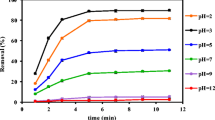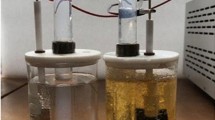Abstract
An electro/Fe2+/persulfate process has been conducted for toluene removal from surfactant (SDS) flushing solution, and the pseudo-second-order reaction rate constant (k 2 value) of toluene removal has been optimized by a response surface methodology (RSM). The results indicated that in this process, the reaction between persulfate and externally added Fe2+ generates sulfate-free radicals, and at the same time, Fe2+ is electro-regenerated at the cathode by the reduction of Fe3+. RSM based on Box–Behnken design (BBD) has been applied to analyze the experimental variables, of which the concentrations of persulfate and Fe2+ showed a positive effect on the rate constant of toluene removal, whereas the concentration of SDS showed a negative effect. The interactions between pairs of variables proved to be significant, such as between SDS, persulfate, and Fe2+ concentrations. ANOVA results confirmed that the proposed models were accurate and reliable for analysis of the variables of the electro/Fe2+/persulfate process. The shapes of the 3D response surfaces and contour plots showed that the SDS, persulfate, and Fe2+ concentrations substantially affected the k 2 value of toluene removal. The results indicated that increasing persulfate or Fe2+ concentration increased the k 2 value, whereas increasing SDS concentration decreased the k 2 value. The reaction intermediates have been identified by GC-MS, and a plausible degradation pathway for toluene degradation is proposed.





Similar content being viewed by others
References
Ahmad AL, Ismail S, Bhatia S (2005) Optimization of coagulation-flocculation process for palm oil mill effluent using response surface methodology. Environ Sci Technol 39:2828–2834
Anipsitakis GP, Dionysiou DD (2004) Radical generation by the interaction of transition metals with common oxidants. Environ Sci Technol 38:3705–3712
Anipsitakis GP, Dionysiou DD, Gonzalez MA (2005) Cobalt-mediated activation of peroxymonosulfate and sulfate radical attack on phenolic compounds. Implications of chloride ions. Environ Sci Technol 40:1000–1007
ATSDR (2000) Toxicological profile for toluene. U.S. Department of Health and Human Services, Public Health Service, Atlanta
ATSDR (2001) Interaction profile for benzene, toluene, ethylbenzene and xylenes (BTEX). U.S. Department of Health and Human Services, Public Health Service, Atlanta
Bremner DH, Molina R, Martínez F, Melero JA, Segura Y (2009) Degradation of phenolic aqueous solutions by high frequency sono-Fenton systems (US-Fe2O3/SBA-15-H2O2). Appl Catal B Environ 90:380–388
Do SH, Kwon YJ, Kong SH (2011) Feasibility study on an oxidant-injected permeable reactive barrier to treat BTEX contamination: Adsorptive and catalytic characteristics of waste-reclaimed adsorbent. J Hazard Mater 191:19–25
Esteve-Turrillas FA, Armenta S, Garrigues S, Pastor A, de la Guardia M (2007) Headspace-mass spectrometry determination of benzene, toluene and the mixture of ethylbenzene and xylene isomers in soil samples using chemometrics. Anal Chim Acta 587:89–96
Ferreira SLC, Bruns RE, Ferreira HS, Matos GD, David JM, Brandão GC, da Silva EGP, Portugal LA, dos Reis PS, Souza AS, dos Santos WNL (2007) Box-Behnken design: An alternative for the optimization of analytical methods. Anal Chim Acta 597:179–186
Gong YH, Zhang H, Li YL, Xiang LJ, Royer S, Valange S, Barrault J (2010) Evaluation of heterogeneous photo-Fenton oxidation of Orange II using response surface methodology. Water Sci Technol 62:1320–1326
He L, Huang GH, Lu HW, Zeng GM (2008) Optimization of surfactant-enhanced aquifer remediation for a laboratory BTEX system under parameter uncertainty. Environ Sci Technol 42:2009–2014
Huang KC, Zhao ZQ, Hoag GE, Dahmani A, Block PA (2005) Degradation of volatile organic compounds with thermally activated persulfate oxidation. Chemosphere 61:551–560
Jiang XX, Wu YL, Wang P, Li HJ, Dong WB (2013) Degradation of bisphenol A in aqueous solution by persulfate activated with ferrous ion. Environ Sci Pollut Res 20:4947–4953
Kayan B, Gözmen B (2012) Degradation of Acid Red 274 using H2O2 in subcritical water: Application of response surface methodology. J Hazard Mater 201–202:100–106
Kenshi H (1975) A rapid determination of sodium dodecyl sulfate with methylene blue. Anal Biochem 67:503–506
Kubinec R, Adamuščin J, Jurdáková H, Foltin M, Ostrovský I, Kraus A, Soják L (2005) Gas chromatographic determination of benzene, toluene, ethylbenzene and xylenes using flame ionization detector in water samples with direct aqueous injection up to 250 μl. J Chromatogr A 1084:90–94
Kusic H, Peternel I, Ukic S, Koprivanac N, Bolanca T, Papic S, Bozic AL (2011) Modeling of iron activated persulfate oxidation treating reactive azo dye in water matrix. Chem Eng J 172:109–121
Laha S, Tansel B, Ussawarujikulchai A (2009) Surfactant-soil interactions during surfactant-amended remediation of contaminated soils by hydrophobic organic compounds: A review. J Environ Manage 90:95–100
Lee DH, Cody RD, Kim DJ (2002a) Surfactant recycling by solvent extraction in surfactant-aided remediation. Sep Purif Technol 27:77–82
Lee DH, Cody RD, Kim DJ, Choi S (2002b) Effect of soil texture on surfactant-based remediation of hydrophobic organic-contaminated soil. Environ Int 27:681–688
Li XF, Zhou QX, Luo Y, Yang G, Zhou T (2013) Joint action and lethal levels of toluene, ethylbenzene, and xylene on midge (Chironomus plumosus) larvae. Environ Sci Pollut Res 20:957–966
Liang CJ, Huang CF, Chen YJ (2008) Potential for activated persulfate degradation of BTEX contamination. Water Res 42:4091–4100
Liang CJ, Chen YJ, Chang KJ (2009) Evaluation of persulfate oxidative wet scrubber for removing BTEX gases. J Hazard Mater 164:571–579
Lin H, Wu J, Zhang H (2013) Degradation of bisphenol A in aqueous solution by a novel electro/Fe3+/peroxydisulfate process. Sep Purif Technol 117:18–23
Lin H, Wu J, Zhang H (2014) Degradation of clofibric acid in aqueous solution by an EC/Fe3+/PMS process. Chem Eng J 244:514–521
Long AH, Zhang H, Lei Y (2013) Surfactant flushing remediation of toluene contaminated soil: Optimization with response surface methodology and surfactant recovery by selective oxidation with sulfate radicals. Sep Purif Technol 118:612–619
Long AH, Lei Y, Zhang H (2014a) Degradation of toluene by a selective ferrous ion activated persulfate oxidation process. Ind Eng Chem Res 53:1033–1039
Long AH, Lei Y, Zhang H (2014b) In situ chemical oxidation of organic contaminated soil and groundwater using activated persulfate process. Prog Chem 26:898–908
Nair AT, Ahammed MM (2014) Coagulant recovery from water treatment plant sludge and reuse in post-treatment of UASB reactor effluent treating municipal wastewater. Environ Sci Pollut Res 21:10407–10418
Nomiya K, Hashino K, Nemoto Y, Watanabe M (2001) Oxidation of toluene and nitrobenzene with 30 % aqueous hydrogen peroxide catalyzed by vanadium(V)-substituted polyoxometalates. J Mol Catal A Chem 176:79–86
Rastegar SO, Mousavi SM, Shojaosadati SA, Sheibani S (2011) Optimization of petroleum refinery effluent treatment in a UASB reactor using response surface methodology. J Hazard Mater 197:26–32
Romero A, Santos A, Vicente F, González C (2010) Diuron abatement using activated persulphate: Effect of pH, Fe(II) and oxidant dosage. Chem Eng J 162:257–265
Sekaran G, Karthikeyan S, Boopathy R, Maharaja P, Gupta VK, Anandan C (2014) Response surface modeling for optimization heterocatalytic Fenton oxidation of persistence organic pollution in high total dissolved solid containing wastewater. Environ Sci Pollut Res 21:1489–1502
Shukla PR, Wang SB, Ang HM, Tadé MO (2010) Photocatalytic oxidation of phenolic compounds using zinc oxide and sulphate radicals under artificial solar light. Sep Purif Technol 70:338–344
Singh KP, Singh AK, Gupta S, Rai P (2012) Modeling and optimization of reductive degradation of chloramphenicol in aqueous solution by zero-valent bimetallic nanoparticles. Environ Sci Pollut Res 19:2063–2078
Tan C, Gao N, Deng Y, Rong W, Zhou S, Lu N (2013) Degradation of antipyrine by heat activated persulfate. Sep Purif Technol 109:122–128
Tsitonaki A, Petri B, Crimi M, Mosbaek H, Siegrist RL, Bjerg PL (2010) In situ chemical oxidation of contaminated soil and groundwater using persulfate: A review. Crit Rev Env Sci Technol 40:55–91
Van Durme J, Dewulf J, Sysmans W, Leys C, Van Langenhove H (2007) Abatement and degradation pathways of toluene in indoor air by positive corona discharge. Chemosphere 68:1821–1829
Vicente F, Santos A, Romero A, Rodriguez S (2011) Kinetic study of diuron oxidation and mineralization by persulphate: Effects of temperature, oxidant concentration and iron dosage method. Chem Eng J 170:127–135
Wang YR, Chu W (2011) Degradation of 2,4,5-trichlorophenoxyacetic acid by a novel Electro-Fe(II)/Oxone process using iron sheet as the sacrificial anode. Water Res 45:3883–3889
Wang X, Wu J, Zhao M, Lv Y, Li G, Hu C (2009) Partial oxidation of toluene in CH3COOH by H2O2 in the presence of VO (acac)2 catalyst. J Phy Chem C 113:14270–14278
Wu J, Zhang H, Oturan N, Wang Y, Chen L, Oturan MA (2012a) Application of response surface methodology to the removal of the antibiotic tetracycline by electrochemical process using carbon-felt cathode and DSA (Ti/RuO2–IrO2) anode. Chemosphere 87:614–620
Wu J, Zhang H, Qiu JJ (2012b) Degradation of Acid Orange 7 in aqueous solution by a novel electro/Fe2+/peroxydisulfate process. J Hazard Mater 215–216:138–145
Xu HB, Zhao DY, Li YJ, Liu PY, Dong CX (2014) Enhanced degradation of ortho-nitrochlorobenzene by the combined system of zero-valent iron reduction and persulfate oxidation in soils. Environ Sci Pollut Res 21:5132–5140
Ying GG (2006) Fate, behavior and effects of surfactants and their degradation products in the environment. Environ Int 32:417–431
Zhang H, Choi HJ, Canazo P, Huang CP (2009) Multivariate approach to the Fenton process for the treatment of landfill leachate. J Hazard Mater 161:1306–1312
Zhang H, Li YL, Wu XG, Zhang YJ, Zhang DB (2010) Application of response surface methodology to the treatment landfill leachate in a three-dimensional electrochemical reactor. Waste Manage 30:2096–2102
Zhang H, Li YL, Zhong X, Ran XN (2011a) Application of experimental design methodology to the decolorization of Orange II using low iron concentration of photoelectro-Fenton process. Water Sci Technol 63:1373–1380
Zhang H, Ran XN, Wu XG, Zhang DB (2011b) Evaluation of electro-oxidation of biologically treated landfill leachate using response surface methodology. J Hazard Mater 188:261–268
Zhang H, Wang Z, Liu CC, Guo YZ, Shan N, Meng CX, Sun LY (2014) Removal of COD from landfill leachate by an electro/Fe2+/peroxydisulfate process. Chem Eng J 250:76–82
Zhao L, Hou H, Fujii A, Hosomi M, Li FS (2014) Degradation of 1,4-dioxane in water with heat- and Fe2+-activated persulfate oxidation. Environ Sci Pollut Res 21:7457–7465
Zhou DN, Zhang H, Chen L (2014) Sulfur-replaced Fenton systems: can sulfate radical substitute hydroxyl radical for advanced oxidation technologies? J Chem Technol Biotechnol. doi:10.1002/jctb.4525
Acknowledgments
This work was supported by the National Natural Science Foundation of China (Grant No 20977069). LONG A.H. would like to acknowledge the Ph.D. Research Startup Foundation of Jiangxi Science and Technology Normal University (Grant No. 3000990115).
Conflict of interest
The authors declare that there is no conflict of interests regarding the publication of this article.
Author information
Authors and Affiliations
Corresponding author
Additional information
Responsible editor: Angeles Blanco
Electronic supplementary material
Below is the link to the electronic supplementary material.
ESM 1
(DOC 476 KB)
Rights and permissions
About this article
Cite this article
Long, A., Zhang, H. Selective oxidative degradation of toluene for the recovery of surfactant by an electro/Fe2+/persulfate process. Environ Sci Pollut Res 22, 11606–11616 (2015). https://doi.org/10.1007/s11356-015-4406-x
Received:
Accepted:
Published:
Issue Date:
DOI: https://doi.org/10.1007/s11356-015-4406-x




